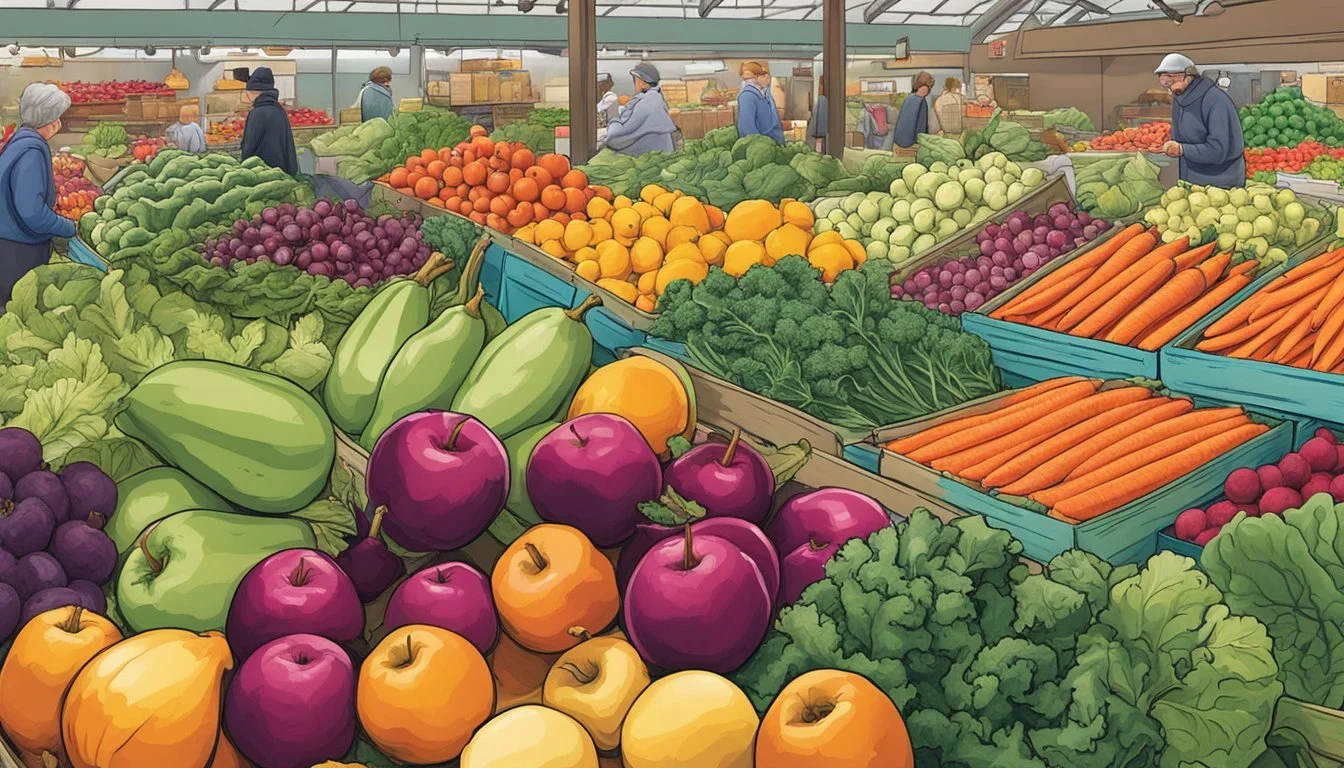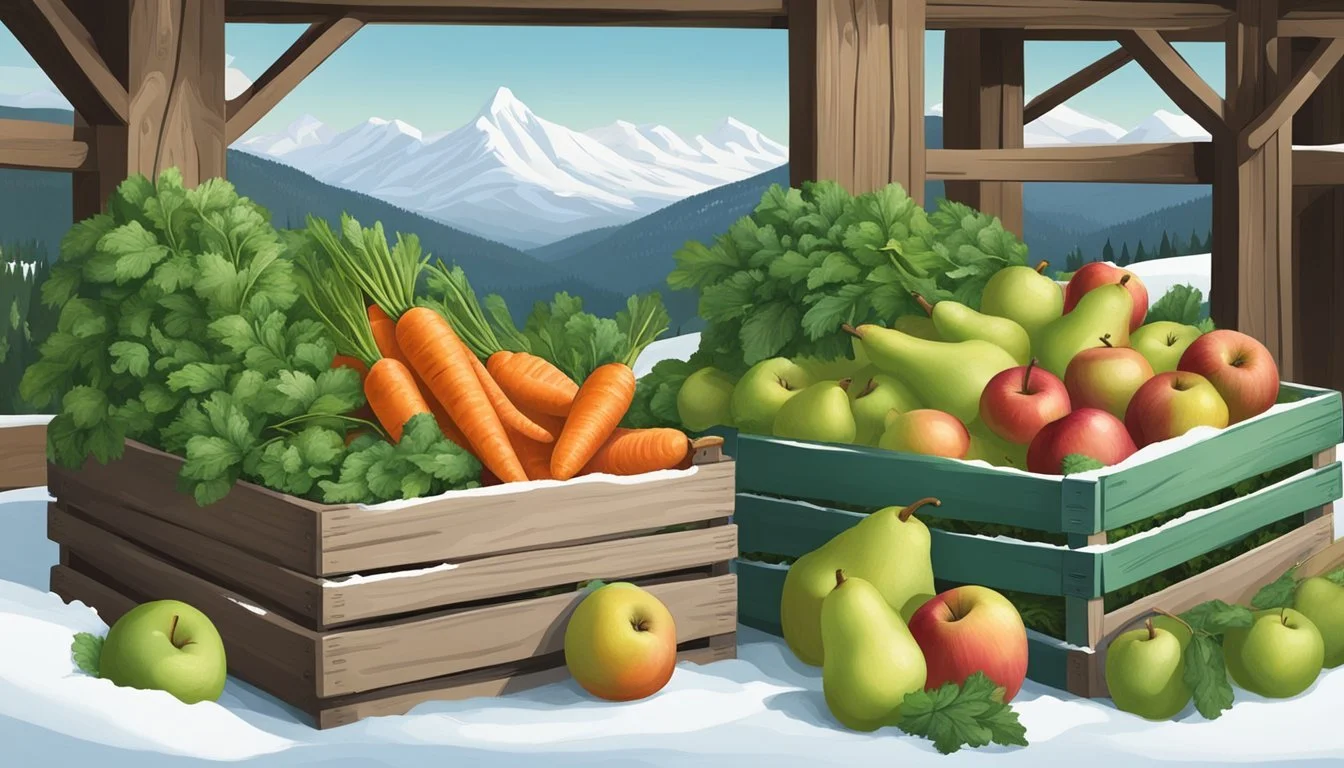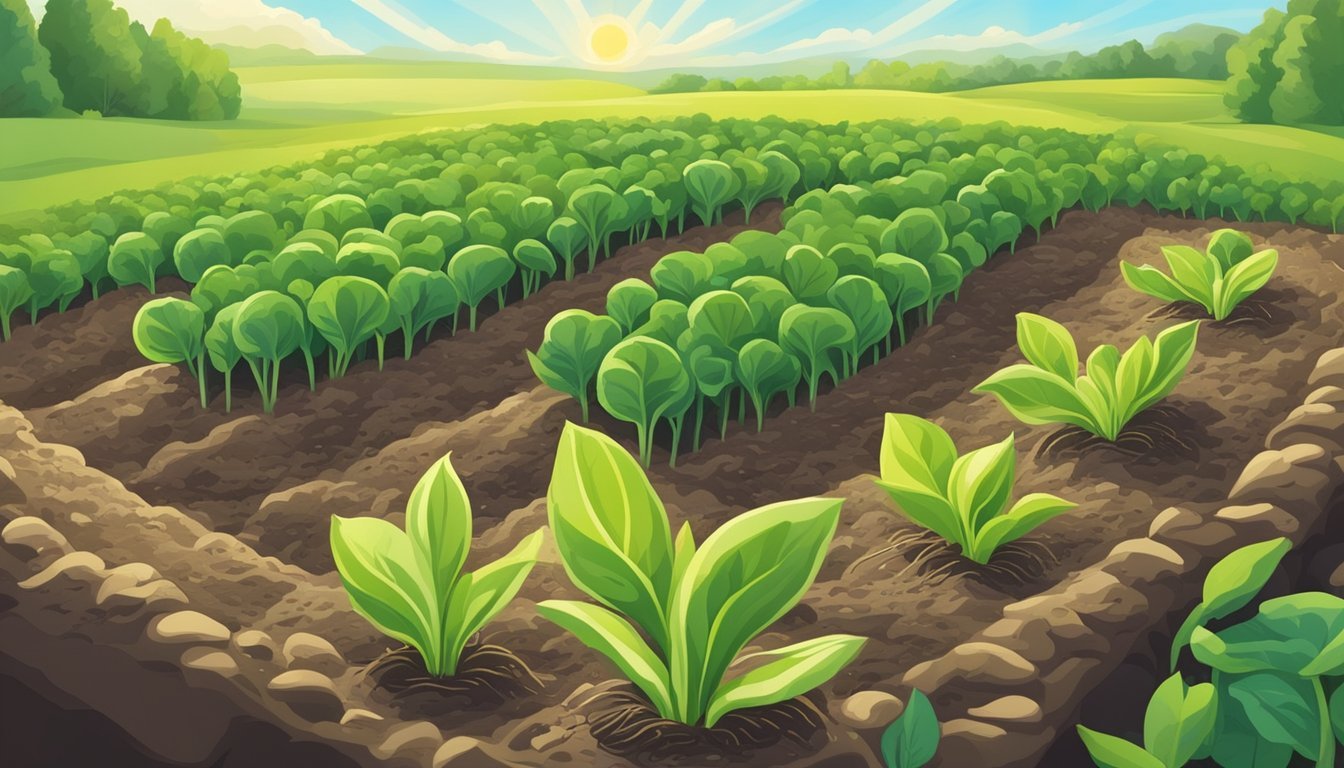Vermont Seasonal Fruit & Vegetables in March
Your Guide to Fresh Produce
This Article is Part of our Vermont Seasonal Fruit & Veg Calendar
March in Vermont witnesses the transition from winter's tail to the whisper of spring, a time when the state’s agricultural industry begins to reawaken. While the selection of fresh produce available may not be as abundant as the summer months, there are still a variety of fruits (What wine goes well with fruit?) and vegetables that are in season. Vermonters and visitors alike value the fresh, locally-sourced produce that begins to appear in farmers' markets and on roadside stands.
The state's cold climate and unique terroir contribute to the growth of certain crops that can withstand the chill of early spring. Among the available produce, root vegetables like parsnips and carrots (how long do carrots last?) continue to be staples. These hardy vegetables not only survive but thrive in the cool temperatures, storing well through the winter months. Greens such as kale (What wine goes well with kale?) and spinach (What wine goes well with spinach?), known for their resilience, start becoming more prominent and can be found crisp and fresh. March also marks the time when greenhouse growers start to supply an early yield of some warmer-weather crops such as tomatoes and cucumbers, providing a glimpse of the variety that is to come with the warmer temperatures.
Despite the limited fresh fruit options during this time, apples from the previous fall’s harvest are still available and maintain their quality when properly stored. Maple syrup (how long does maple syrup last?) production is in full swing with the Maple Open House Weekend typically taking place in March. This event allows consumers to visit sugarhouses, experience the sugaring process first-hand, and enjoy the fresh taste of pure Vermont maple syrup. Overall, the emphasis in March is on enjoying the last of the winter storage while looking forward to the promise of spring's bounty.
Overview of Vermont's Seasonal Produce
March in Vermont is a transitional period when winter wanes and early signs of spring emerge. The seasonal offerings of fruits and vegetables reflect this transition. As the state shakes off the frost, local farms begin to provide a variety of produce known for their freshness and flavor during this month.
Fruits: While March is not peak season for fruit in Vermont, consumers can still find storage apples that maintain their crispness and taste when kept in controlled environments. These apples are the remnants of the fall season, offering a sweet and tangy experience.
Vegetables: Root vegetables are abundant in March, with items such as carrots, potatoes, and onions readily available. They are often stored from the previous harvest, ensuring a sustained supply. This is also a good time to find fresh greens grown in greenhouses, such as spinach and arugula, which begin to appear as the days grow longer.
Availability:
Apples: Stored from fall, still crisp and enjoyable
Root Vegetables:
Carrots and Potatoes: Available from storage, versatile in cooking
Onions: Essential for flavor, available from storage
Greenhouse Greens: Limited but fresh, signaling the start of spring produce
The tail end of winter limits the variety of fresh produce typically associated with Vermont, but it still offers a selection that is at peak flavor. The state's farmers markets and retail stores make these items accessible to consumers, ensuring that even in early March, Vermonters have access to fresh, nutritious produce suited to the season.
March in Vermont: Transitioning Seasons
As March arrives in Vermont, it embodies the quintessential shift from the cold, dormant winter to the cusp of an awakening spring. This period significantly influences the seasonal produce availability and farming activities.
From Winter to Spring
March in Vermont heralds the transition between seasons, as the landscape slowly shifts from the white of winter to the first hints of spring's green. Winter's grip begins to loosen, though the weather can still fluctuate dramatically, with snowfall and frost a common occurrence. This variability means the harvest for many crops isn't yet in full swing, but preparations for spring planting are underway. Farmers often start seeds indoors and plan for the upcoming growing season.
Climatic Influence on Produce
The climate of Vermont in March can be unpredictable, with temperatures ranging from crisp cold to milder spells that hint at spring. This climatic duality affects what produce is available. Root vegetables and stored goods like apples and squashes, remnants of the winter's bounty, are typically available, while hardy greens might begin to make an appearance in outdoor or protected environments. The lengthening days and gradually warming soil temperatures allow for the earliest spring crops, such as radishes and spinach, to be planted, although they are not yet ready for harvest.
Seasonal Fruits in March
In March, Vermont's fruit selection begins to transition from winter staples to early spring offerings, with a focus on the last harvests of durable fruit and the influx of tangy citrus varieties.
Last of Winter's Apples
In Vermont, March marks the end of the season for winter apples. While most of the harvest occurs in late summer and autumn, some hardy apple varieties are stored and remain available through early spring. Their flavor remains robust, though their texture may no longer be at its peak crispness. These apples are excellent for cooking and baking, as their concentrated flavors enhance sweet and savory dishes alike.
Citrus Varieties
Citrus fruit, while not endemic to Vermont's colder climate, becomes more available in markets during March. Varieties such as oranges, grapefruits, lemons, and limes are imported in their prime, offering a burst of fresh flavor that contrasts the waning winter palate. These fruits are harvested at their peak in warmer climates and shipped to Vermont, bringing a much-welcomed tang and brightness to the local food scene during the tail-end of winter.
Seasonal Vegetables in March
In Vermont, March signals the tail end of winter and the start of spring, where a variety of hardy greens and root vegetables are available, while a few early spring vegetables begin to make their appearance.
Hearty Greens and Root Vegetables
During March, root vegetables are prominently available from winter storage. These typically include:
Potatoes: A staple root vegetable, offering versatility in a range of dishes.
Carrots: Sweet and crunchy, ideal for both raw and cooked applications.
Fresh hearty greens like kale and spinach are still in good supply. They thrive in the cold and can be enjoyed in various dishes:
Kale: High in nutrients, it can be used in salads, soups, and stir-fries.
Spinach: Tender and flavorful, suitable for salads, sautés, and as a cooked side.
Early Spring Vegetables
As the ground begins to thaw, some early spring vegetables start their season. These vegetables include:
Broccoli: Rich in vitamins, best enjoyed steamed or roasted.
Cabbage: It remains in season and is perfect for hearty stews.
Cauliflower: Versatile in recipes, whether roasted, steamed, or blended into soups.
The transition from winter to spring allows these vegetables to be harvested and bring freshness to the table, reflecting the seasonal shift in Vermont's agricultural landscape.
Herbs and Other March Produce
In Vermont during March, the selection of fresh produce begins to expand as the state slowly transitions into spring. Among the herbs, parsley and thyme are two staples that start to flourish again. They are often utilized by home cooks and professional chefs alike for their versatility and profound flavor they contribute to dishes.
Parsley, with its bright green leaves and clean, peppery taste, is an excellent source of vitamins A, C, and K, and it's commonly used as a garnish or a flavor-enhancing ingredient. Thyme, characterized by its small, fragrant leaves, is a robust herb perfect for hearty March dishes.
Here are some herbs and vegetables that are typically available in March:
Herbs: Parsley, Thyme
Vegetables:
Root vegetables: continue from winter, including carrots and parsnips.
Greens: Kale and lettuce might be available, weather permitting.
Alliums: Leeks may also make an appearance.
While these herbs and vegetables are becoming more accessible, many of Vermont's farmers and growers utilize greenhouses or cold frames to protect these delicate plants from the still-chilly temperatures. Hence, availability might vary based on specific local growing practices and weather conditions of the year.
Consumers eager to enjoy these fresh herbs and vegetables can typically find them at local farmers' markets, food co-ops, and sometimes in the produce section of grocery stores that stock local produce. Supporting local agriculture not only contributes to the community but also ensures that one is getting some of the freshest possible ingredients.
Preparing and Enjoying March's Bounty
March in Vermont presents a fresh palate of produce that can elevate the culinary experience with season-fresh flavors. This section walks through effective cooking techniques for vegetables and fun incorporations of fruits into the diet.
Cooking Techniques for Seasonal Vegetables
Roasting: A variety of March vegetables such as parsnips and turnips can be brought to life through roasting. Roasting enhances their natural sweetness and adds a comforting, caramelized character to dishes. Simply toss them in a bit of olive oil, season with salt and pepper, and roast at 400°F until tender and golden.
Pasta Integration: Vegetables like spinach and kale, which begin to come into season, are easily integrated into pasta (how long does pasta last?) dishes. They can be sautéed quickly with garlic and olive oil, then mixed into pasta alongside a sprinkle of parmesan cheese for a nutritious and satisfying meal.
Incorporating Fruits into Your Diet
Salads: While fruits are sparse, apples stored from fall can be sliced into salads for a crisp, sweet addition. They pair well with end-of-winter greens like spinach, nuts, and a tangy vinaigrette, bringing freshness and vibrancy to the plate.
Desserts and Snacks: Apple slices can be baked with a sprinkle of cinnamon for a healthy dessert option or diced into yogurt or oatmeal for a morning snack, adding a fruity element to otherwise savory or plain dishes.
Growing Your Own March Produce
In March, gardeners in Vermont are preparing for the growing season by starting seeds indoors and employing specific gardening techniques for early vegetables. It's important to maximize this time to ensure a bountiful harvest later in the year.
Indoor Starting for Spring Planting
Gardeners should begin by starting seeds indoors for crops such as tomatoes, peppers, and eggplants. These fruits require a longer growing period and benefit from an early start. A few key points include:
Temperature: Maintain a steady temperature between 65°F and 75°F to encourage germination.
Light: Provide plenty of light, using grow lights if natural light is insufficient.
Gardening Tips for Early Vegetables
Early vegetables like peas, spinach, and lettuce can withstand March's cool temperatures. When planting these early vegetables, consider the following:
Soil Preparation: Amend the soil with compost to provide nutrients and improve structure.
Protection: Use row covers to protect early vegetables from frost and pests.
Buying Local: Vermont's Farmers Markets
While March in Vermont may not be the peak season for fresh produce, local farmers markets remain a hub for community engagement and still offer a variety of goods. Vermont's farmers markets embrace the state's agricultural heritage and focus on providing seasonal, locally-sourced items.
During March, while the selection of fresh fruits and vegetables is more limited, visitors can expect to find storage crops such as potatoes, onions, and carrots. Maple products, a Vermont staple, are also available as March marks the start of maple sugaring (how long does maple sugar last?) season. Local honey and dairy products, along with artisanal crafts, are commonly sold at these markets too.
Here's what shoppers typically find at Vermont farmers markets in March:
Storage Crops: Potatoes, Onions, Carrots
Maple Products: Syrup, Candies
Dairy: Cheese, Milk
Meats: Locally raised beef, pork, and poultry
Crafts: Handmade local goods
Throughout Vermont, the commitment to locally sourced and seasonal products means the farmers markets operate on a seasonal schedule. While the majority of these markets come to life in the warmer months, a select few offer year-round or winter markets that provide residents with ongoing access to local produce and goods.
Shelburne Farmers Market, for example, typically begins its season in May, but other markets might offer indoor or winter-specific market experiences during colder months. Purchasing at these markets supports local farmers and contributes to the state's economy, ensuring the traditions of Vermont's agricultural community continue to thrive.
Conclusion
In March, Vermont's seasonal produce selection begins to transition. Local markets may have limited fresh produce compared to the peak growing months. However, there are still quality options available for those seeking to support local farmers and enjoy seasonal freshness.
Key March Produce:
Potatoes: They are a staple during this time, often available from storage with excellent quality.
Greens: Hardy varieties such as kale may be locally sourced from colder storage or greenhouses.
Apples: Some varieties are still available from cold storage, offering a crisp taste of the previous fall harvest.
When purchasing from Vermont producers in March, consumers not only get to enjoy produce that is often fresher but also contribute to the local economy, affirming a commitment to sustainability and community health. It's essential for buyers to remain aware of what's in season, to adjust expectations regarding variety and to embrace the richness of what is available.
Shopping strategies during this time may include looking for stores or farm markets that source from local producers who utilize indoor growing methods, like greenhouses, to extend the availability of certain vegetables and leafy greens. The anticipation for the diversity of spring and summer harvests grows, but in the interim, comfort can be found in the robust flavors of late-winter offerings.











